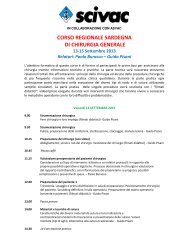58° Congresso Nazionale SCIVAC: Oncologia veterinaria
58° Congresso Nazionale SCIVAC: Oncologia veterinaria
58° Congresso Nazionale SCIVAC: Oncologia veterinaria
You also want an ePaper? Increase the reach of your titles
YUMPU automatically turns print PDFs into web optimized ePapers that Google loves.
58° <strong>Congresso</strong> <strong>Nazionale</strong> <strong>SCIVAC</strong> • Milano, 7-9 Marzo 2008 • <strong>Oncologia</strong> <strong>veterinaria</strong> - Alle soglie del III Millennio<br />
Bladder tumors comprise approximately 1% of all canine malignancies. It<br />
is more common in the dog than the cat. The theory behind this prevalence is<br />
that dogs secrete higher concentrations of the metabolites of tryptophan, a<br />
proposed carcinogen, than cats. Most tumors of the bladder are malignant,<br />
and the most common types include transitional cell carcinoma, squamous<br />
cell carcinoma, and adenocarcinomas. Bladder tumors usually affect older<br />
animals (mean age 10 years), with the exception of rhabdomyosarcomas that<br />
usually affect young animals. Etiology of bladder cancer in dogs and cats is<br />
unknown. However, risk of bladder cancer was found to be significantly increased<br />
in dogs exposed to two or more applications of topical insecticide<br />
commonly used for fleas and ticks, and also by obese body condition. It has<br />
been proposed that body fat acts as a storage depot for chemicals from insecticide<br />
dips resulting in gradual metabolism and excretion of the chemicals and<br />
prolonged exposure of the urothelium to the potential carcinogens. Cigarette<br />
smoking is associated with increased incidence of bladder cancer in people,<br />
and thus it is possible that second hand cigarette smoke exposure in animals<br />
living in smoking households may also play a part in the causation of bladder<br />
tumors. Cyclophosphamide has been incriminated in the development of TCC<br />
of the urinary bladder in dogs and humans. There is also a significant breed<br />
predisposition among dogs, with Scottish Terriers having an 18-fold increased<br />
risk compared to mixed breeds for TCC development. Other breeds with<br />
higher risk include the Beagle, Shetland Sheepdog, Wire Hair Fox Terrier,<br />
And West Highland White Terrier. This breed predisposition may be associated<br />
with differences in activation or detoxification pathways for specific carcinogens,<br />
although precise molecular pathways have yet to be identified.<br />
CLINICAL SIGNS<br />
Clinical signs most often associated with bladder tumors include hematuria,<br />
pollakiuria, and stranguria. Other clinical signs include polyuria, polydipsia,<br />
urinary incontinence, urinary obstruction, abdominal pain, tenesmus, ribbon-like<br />
stool, and lethargy. Physical exam findings may reveal caudal abdominal<br />
mass, prostatomegaly, bladder distention or obstruction, abdominal<br />
pain, weakness, and lymphadenomegaly. Most often, routine blood work and<br />
physical examination are normal and the bladder mass cannot be detected by<br />
abdominal palpation.<br />
DIAGNOSIS<br />
Urinalysis is often consistent with a bacterial cystitis (bacteruria, pyuria,<br />
hematuria, and proteinuria). Neoplastic cells can be identified in the urine se-<br />
90
















